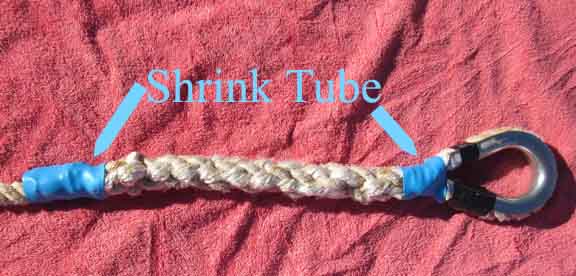

Make a total of three tucks for natural fiber rope, and four tucks for synthetic rope.Continue to tuck in each strand, over and under.All strands should be coming out evenly at the same position around the rope.

#Rope eye splice kit how to#
Splicing is not one of those skills that you can do once and then never forget how to do it. The best way to learn how to splice is to sit down one-on-one with someone who is familiar with the techniques and go over each step a few times until you get used to how the strands are woven together. Even the best drawings of the steps for making a splice can look confusing. Avoid sisal and plastic rope until you have mastered splicing with manila rope. To learn the technique of splicing, it’s best to practice with a short piece of 1/4″ three strand manila rope. If after making the first three tucks on all three strands, you reduce each strand to one-half of its fibers and make a fourth tuck, the splice will have a nice tapered look.
#Rope eye splice kit series#
The rope should maintain approximately 80% of its strength if the splice is made with a series of three tucks on each of the three strands. Also, you should try to pull each set of tucks tight and with even tension. Try to prevent each strand from raveling while you’re working with it. Those first few tucks that you make might look a bit rough, but try to remember that neatness is one of the keys to a well-made splice. The first tuck sets up the pattern for the following tucks and gives the splice a symmetrical appearance. Learning how to make the first tuck on each of the three strands is the key to splicing. The eye splice, back splice and short splice are basic and well suited to the type of pioneering outlined (in this pamphlet.) The splices shown here can be made in any three strand rope (manila, sisal, poly, or nylon). There are a number of rather complicated splices. Splices in ropes make the rope secure and ready to go when needed. Splices are neater and smaller and not likely to come untied in use. In some cases the right knot could do the same job as each of these three splices: a bowline might be used instead of an eye splice a Sheet Bend, Water Knot or Carrick Bend instead of a short splice, and whipping could replace the back splice. The basic process in all three splices is to unlay the strands at the end of the rope, then weave them over and under back into the rope to form the splice. There are three basic types of splices that are typically made on three-strand twisted rope: an eye splice, a back splice, and a short splice. Making splices is not really all that hard to do. Very often, the ability to do a neat job of splicing is placed on the top of the skills list of ropework.

Making the proper splices in the proper places on your ropes is the benchmark of a skilled craftsman. Peschke as presented in the 1998 printing of the 1993 edition of the Pioneering Merit Badge Pamphlet:


 0 kommentar(er)
0 kommentar(er)
